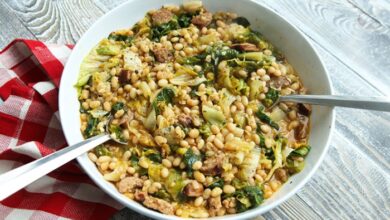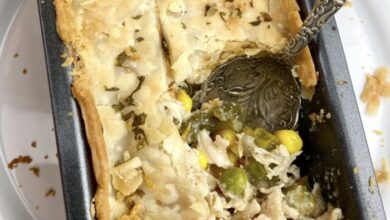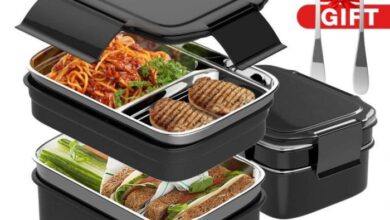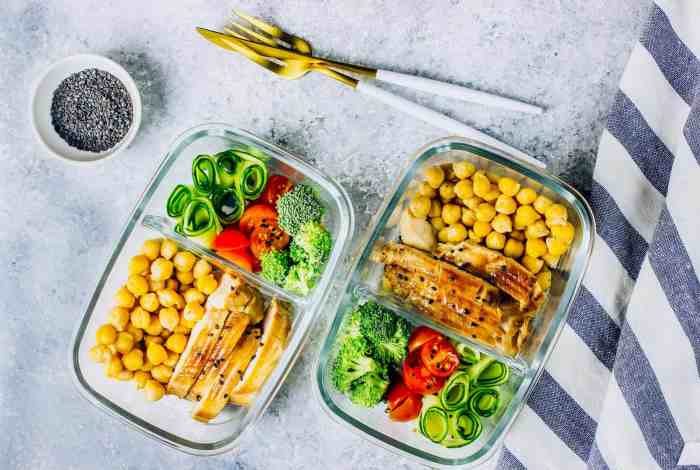
Find The Best Meal Prep Containers For You
Best meal prep containers are essential for anyone who wants to eat healthy and save time. Whether you’re a busy professional, a student, or just someone who loves to cook, having the right containers can make all the difference. But with so many different options available, how do you know which ones are right for you?
In this blog post, we’ll discuss everything you need to know about choosing the best meal prep containers, from the different materials available to the features and functionality that matter most. We’ll also provide tips for organizing your containers, finding the right size and capacity, and even share some delicious meal prep recipes to get you started.
Types of Meal Prep Containers

Meal prepping is a great way to save time and money, and having the right containers is essential. With so many options available, it can be overwhelming to choose the best ones for your needs. Here’s a breakdown of the most common types of meal prep containers and their pros and cons.
When it comes to meal prepping, having the right containers is essential. I love using glass containers for their durability and ability to go from freezer to oven, but I also appreciate the convenience of leak-proof plastic containers for soups like this delicious mongo guisado mung bean soup.
It’s so easy to portion out a few servings for the week, and I know they’ll stay fresh in the fridge until I’m ready to eat them. So, if you’re looking for a great way to make meal prepping a breeze, investing in a good set of containers is definitely worth it!
Glass Meal Prep Containers
Glass meal prep containers are a popular choice because they are durable, microwave-safe, and dishwasher-safe. They are also generally considered to be more environmentally friendly than plastic containers.
- Pros:
- Durable and resistant to scratches and breakage.
- Microwave-safe and oven-safe (depending on the container).
- Dishwasher-safe.
- Environmentally friendly and reusable.
- Free of BPA and other harmful chemicals.
- Cons:
- Heavier than plastic containers.
- More likely to break if dropped.
- Can be more expensive than plastic containers.
Popular brands:Pyrex, Anchor Hocking, Rubbermaid, Glasslock
Plastic Meal Prep Containers
Plastic meal prep containers are a common and affordable option. They are lightweight, easy to clean, and come in a variety of sizes and shapes.
Finding the right meal prep containers is key to staying on track with healthy eating. I love using them to portion out my favorite recipes, like this broiled salmon with homemade teriyaki glaze. The glaze is so flavorful, and the salmon cooks up perfectly in the oven.
With my trusty meal prep containers, I can enjoy this delicious meal throughout the week without any fuss.
- Pros:
- Lightweight and easy to carry.
- Affordable and readily available.
- Come in a wide range of sizes and shapes.
- Often microwave-safe and dishwasher-safe.
- Cons:
- Can leach chemicals into food, especially when heated.
- Not as durable as glass or stainless steel.
- May stain or become discolored over time.
- Not as environmentally friendly as glass or stainless steel.
Popular brands:Rubbermaid, Sistema, Glad, Ziploc
Stainless Steel Meal Prep Containers
Stainless steel meal prep containers are becoming increasingly popular due to their durability and sustainability. They are also generally considered to be healthier than plastic containers.
When it comes to meal prep, having the right containers is key. I love using glass containers for their durability and ability to go from the fridge to the oven. And speaking of delicious treats, I recently made these amazing no bake cookies that are perfect for a quick and easy snack.
I even used my meal prep containers to store them in the fridge for later!
- Pros:
- Durable and resistant to scratches and dents.
- Microwave-safe and oven-safe (depending on the container).
- Dishwasher-safe.
- Environmentally friendly and reusable.
- Free of BPA and other harmful chemicals.
- Cons:
- More expensive than plastic or glass containers.
- Can be heavy and bulky.
- May dent or scratch if dropped.
Popular brands:LunchBots, PlanetBox, U Konserve,
Silicone Meal Prep Containers
Silicone meal prep containers are a relatively new option, but they are gaining popularity for their flexibility and durability. They are also microwave-safe and dishwasher-safe.
- Pros:
- Flexible and easy to store.
- Microwave-safe and oven-safe.
- Dishwasher-safe.
- Durable and resistant to tearing.
- Environmentally friendly and reusable.
- Cons:
- Can be more expensive than plastic or glass containers.
- May not be as durable as stainless steel containers.
- Can be difficult to clean if food sticks to the silicone.
Popular brands:Stasher, Silicone Zone,
Size and Capacity: Best Meal Prep Containers
Choosing the right size and capacity for your meal prep containers is crucial for effective meal planning. It impacts portion control, food storage, and overall convenience. Consider your individual dietary needs, the types of meals you prepare, and the frequency of your meal prep sessions when selecting container sizes.
Container Sizes and Recommended Uses
The size and capacity of meal prep containers vary significantly. It is important to choose the right size for your individual needs and the types of meals you prepare.
| Size | Capacity | Recommended Use | Example Meal |
|---|---|---|---|
| Small | 12-16 oz | Single serving of salads, soups, or snacks | Greek yogurt with berries and granola |
| Medium | 20-24 oz | Single serving of larger meals or multiple servings of smaller meals | Chicken stir-fry with brown rice |
| Large | 32-40 oz | Multiple servings of larger meals or large portions of food for later use | Lasagna with a side of salad |
| Extra Large | 48-64 oz | Large meals for multiple people or storing large quantities of leftovers | Roast chicken with roasted vegetables |
Features and Functionality

Meal prep containers are more than just boxes for storing food. They come with a variety of features that make them essential tools for healthy eating and efficient meal planning. These features impact how you store, transport, reheat, and even freeze your meals, making them a worthwhile investment for anyone who wants to simplify their life and improve their diet.
Leak-Proof Lids
Leak-proof lids are a crucial feature for meal prep containers, especially for transporting liquid-based meals like soups, stews, and sauces. These lids prevent spills and messes, ensuring your food stays contained and your bag or lunchbox remains clean. The design of leak-proof lids varies, with some featuring a tight seal, while others have a gasket or a silicone ring to create a barrier against leaks.
Airtight Seals
Airtight seals are vital for preserving the freshness and quality of your food. These seals prevent air from entering the container, which can cause oxidation, leading to food spoilage and loss of flavor. Airtight containers are particularly important for storing delicate ingredients like leafy greens, fruits, and certain meats, which are more susceptible to spoilage.
Microwave-Safe Designs
Microwave-safe meal prep containers are a must-have for busy individuals who need to reheat their meals quickly and easily. These containers are made from materials that can withstand the heat of a microwave, allowing you to safely reheat your food without transferring it to another dish.
However, it is important to check the manufacturer’s instructions before microwaving, as some containers may have specific guidelines for reheating.
Freezer-Safe Options
Freezer-safe meal prep containers are ideal for meal prepping in advance and storing your meals for later consumption. These containers are made from durable materials that can withstand the cold temperatures of a freezer without cracking or breaking. They allow you to prepare a week’s worth of meals in advance, making it easier to stick to a healthy eating plan.
Comparison of Features, Best meal prep containers
| Feature | Advantages | Disadvantages |
|---|---|---|
| Leak-Proof Lids | Prevents spills and messes, ideal for liquid-based meals. | May be more difficult to open and close. |
| Airtight Seals | Preserves food freshness and quality, prevents oxidation and spoilage. | Can be more difficult to clean. |
| Microwave-Safe Designs | Allows for quick and easy reheating, convenient for busy individuals. | Some containers may have specific reheating guidelines. |
| Freezer-Safe Options | Ideal for meal prepping in advance, allows for long-term storage. | May not be suitable for all types of food. |
Organization and Storage
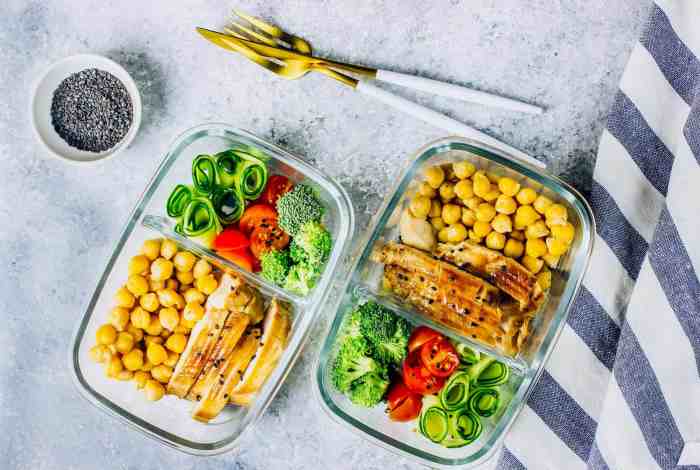
Meal prep containers are an essential part of a healthy and organized lifestyle. However, proper organization is key to maximizing their benefits and ensuring your meals stay fresh and readily available. Here are some effective strategies for organizing your meal prep containers and keeping your kitchen clutter-free.
Labeling and Dating
Labeling and dating your meal prep containers is crucial for maintaining freshness and preventing food waste.
- Clear Labels:Use permanent markers or waterproof labels to write the contents of each container. Be specific, noting the type of dish, ingredients, and any specific dietary needs (e.g., “Chicken Stir-Fry with Brown Rice – Gluten-Free”).
- Date for Freshness:Write the date the meal was prepared on the container. This helps you track how long the food has been stored and ensures you consume it within its recommended shelf life.
- Visual Reminders:Consider using color-coded labels or stickers to categorize meals based on their intended use (e.g., breakfast, lunch, dinner). This can make it easier to grab the right container for your needs.
Stacking and Dividers
Maximizing space and accessibility in your refrigerator or freezer is vital. Stackable containers and dividers are your allies in this quest.
- Stackable Containers:Opt for meal prep containers designed for stacking. These containers often feature airtight lids that create a secure seal and prevent spills or odors. Look for containers with different heights to accommodate various meal sizes.
- Dividers and Trays:Utilize dividers or trays to separate different types of meals or create designated sections within your refrigerator. This helps maintain organization and prevents cross-contamination.
- Shelf Organizers:Consider using shelf organizers or drawer dividers to create dedicated spaces for your meal prep containers. This can help maximize vertical space and keep your fridge tidy.

